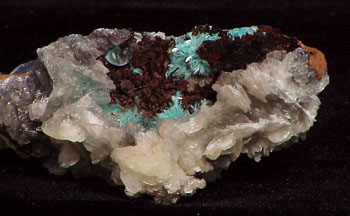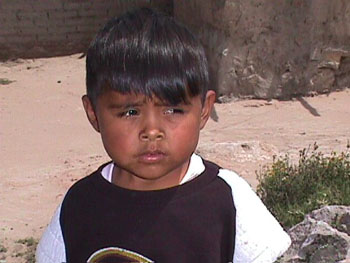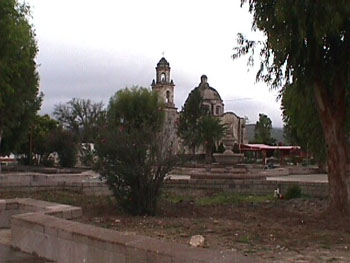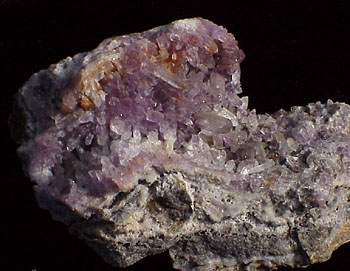 |
|||
|
|||
|
Copyright
Mineral Collecting in Santa Eulalia, Mapimi, and Cerro del Mercado, Mexico
Santa EulaliaSanta Eulalia, an old and more or less constant producer, is one of my favorites. The city served as the first state capital, but was eventually abandoned as the seat of government because of lack of water. Moreover, the lack of water inhibited the milling of the ore. As a result, the government, mill and smelter moved closer to the river, about 15 kilometers away.The mines of Santa Eulalia are closed now, except for the mine at San Antonio El Grande which is in the east camp about 6 miles from the west camp and about a half hour by road. The recent finds at the San Antonio mine have turned up great creedite, some very nice arsenopyrites, nice fluorites of blue, purple and green, and of course, the ever present hemimorphite (Figures 1 and 2). Hemimorphite is always interesting and often spectacular from this area. Many mineral labels only mention Chihuahua as the locality, but neglect to mention Santa Eulalia. Other names for the district that may appear on labels include Aquiles Serdan or Francisco Portillo.
MapimiThe state of Durango, located south of Chihuahua, is home to two famous localities, Mapimi and Cerro del Mercado, which I like to visit. Mapimi is the most spectacular of the two, by far.On entering Mapimi, one sees the sign welcoming you to the town and directing you to the "Puente Colgante", or the hanging bridge. This bridge was built by the Roebling Company and saved miners an arduous journey down a canyon and back up to haul the ore to the road head. The bridge connects the mail shaft of the Ojuela mine and the "town" side of the canyon. The canyon is about 200 meters deep and the bridge spans about 400 meters. It is great to stand there and watch it sway gently in the breeze. Yes, I have walked across it. The mines at Mapimi, over 400 years old, have produced thousands of tons of metal and countless specimens. Minerals from these mines include durangite, adamite, aurichalcite (see Figure 3), conicalcite, which are well known to collectors around the world. There are many more that could be listed here. I enjoy the tremendous variety of minerals found at Mapimi.
Near the mines, on the other side of the mountain, is a spectacular natural cavern. This cavern was going to be developed by the government of Mexico. However, like many things in Mexico, it just never got done. There is, however, a marvelous spiral staircase down from the surface, replacing the old rope system.
Cerro del MercadoCerro del Mercado used to sit outside of Durango by a kilometer or two. Now the city has marched right up the flanks of the hill to the very edge of the mine. Originally explored by a gentleman from Spain, of course, named Mercado, it was thought to have gold. The "Iron Had" or gossan was an indicator of some heavy mineralization and it also indicated gold in some areas. The explorers soon realized the mine only contained iron, to their disappointment.The mine, however, is of interest to collectors, because of the presence of apatite crystals (Figure 4). The largest apatite crystal I saw from this locality was approximately 10 cm across and 15 cm high. The interiors of these crystals were very heavily fractured, but the external surfaces were not marred. The fractures come from internal stresses and from some of the high velocity shots of explosives. On our last trip we hit a pocket containing several thousand crystals. We worked for several hours and barely made a significant dent in the pocket. Among the other minerals found at this locality are martite, common opal, apatite, asbestos and chalcedony.
Scenes from MexicoThe area around Tepatate, San Luis Potosi resembles the Topaz Mountain area of Utah. It appears to be the same rock and the topaz seems to be almost identical. Don Antonio, 75 years old, is the only active miner of the topaz here (Figure 5). The light patch on the hill is one of the digs. Many of the children, like little Antonio (Figure 6), are casual collectors from the streambeds and flats. There is also tin found here. Tin mines are found a few miles from here and the children find nodules of tin ore in the streams around the area. It looks like slightly pinkish round lumps of inordinate weight for its size.
This article may not be copied, distributed or reprinted in any form without the author's permission. To contact the author, please use the e-mail address provided. If you are unable to contact the author, please contact the Canadian Rockhound. Authorized reprints must acknowledge the author and the Canadian Rockhound.
|
||

Copyright © 2000 Canadian Rockhound
Back Issues |
News & Events |
Junior Rockhound |
Resources
|
|||







